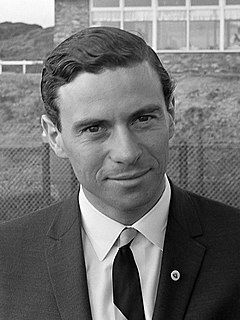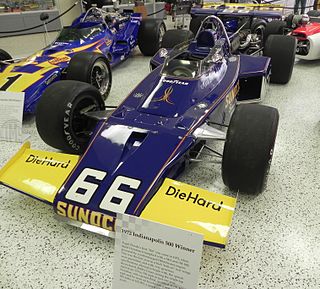
James Clark Jr. OBE was a British Formula One racing driver from Scotland, who won two World Championships, in 1963 and 1965. A versatile driver, he competed in sports cars, touring cars and in the Indianapolis 500, which he won in 1965. He was particularly associated with the Lotus marque.

Anthony Joseph Foyt Jr. is an American retired auto racing driver who has raced in numerous genres of motorsports. His open wheel racing includes United States Automobile Club Champ cars, sprint cars, and midget cars. He raced stock cars in NASCAR and USAC. He won several major sports car racing events. He holds the USAC career wins record with 159 victories, and the American championship racing career wins record with 67.
Michael Henderson Spence was a British racing driver from England. He participated in 37 Formula One World Championship Grands Prix, debuting on 8 September 1963. He achieved one podium, and scored a total of 27 championship points. He also participated in numerous non-Championship Formula One races, as well as sports car racing.

James Hurtubise was an American race car driver who raced in USAC Champ Cars, as well as sprint cars and stock cars. He was from North Tonawanda, New York. Hurtubise enjoyed a lot of success in sprint cars, champ dirt cars, and stock cars but never achieved the success at the Indy 500 that his rookie qualifying run promised when he out qualified pole sitter Eddie Sachs by three mph, nearly breaking the 150 mph mark. "Herk" was a fan favorite throughout much of his career because of his fun-loving attitude and his hard driving style.

The 49th International 500-Mile Sweepstakes was held at the Indianapolis Motor Speedway in Speedway, Indiana on Monday, May 31, 1965.
This article discusses the year-by-year history of the Indianapolis 500 race.

The 52nd International 500 Mile Sweepstakes was held at the Indianapolis Motor Speedway in Speedway, Indiana on Thursday May 30, 1968. For the second year in a row, one of Andy Granatelli's STP Turbine-powered machines was leading late in the race, but once again, it failed within sight of victory.

The Lotus 38 was the first rear-engined car to win the Indianapolis 500, in 1965, driven by Jim Clark. It was run by Lotus at Indianapolis from 1965 to 1967; a total of 8 were built, most for use by Lotus, but several were sold for use by other drivers, including A. J. Foyt and Mario Andretti.

The 56th 500 Mile International Sweepstakes was held at the Indianapolis Motor Speedway in Speedway, Indiana, on Saturday, May 27, 1972. The race is notable in that for the first time, the cars were permitted bolt-on wings, and speeds climbed dramatically. Bobby Unser won the pole position at a then-remarkable speed of 195.940 mph (315.3 km/h) for four laps, breaking Peter Revson's track record of 178.696 mph (287.6 km/h) from 1971 by 17.244 mph (27.8 km/h) – the largest one-year track record increase in Indy history. The race average speed of 162.962 mph (262.3 km/h) was also a new record, which stood until 1984.

The 59th 500 Mile International Sweepstakes was held at the Indianapolis Motor Speedway in Speedway, Indiana on Sunday, May 25, 1975. A. J. Foyt started on the pole position and Bobby Unser won his second Indianapolis 500. Dan Gurney, one of the founders of All American Racers, who finished second as a driver himself in 1968–1969, won his first and only Indy 500 as a car owner. Gurney's Eagle chassis itself scored its third "500" win. The race was part of the 1975 USAC National Championship Trail.

The 50th International 500-Mile Sweepstakes was held at the Indianapolis Motor Speedway in Speedway, Indiana on Monday, May 30, 1966. The official program cover for the race celebrated both the 50th running of the race, and 150th anniversary of Indiana statehood.

The 48th International 500-Mile Sweepstakes was held at the Indianapolis Motor Speedway in Speedway, Indiana on Saturday, May 30, 1964. It was won by A. J. Foyt, but is primarily remembered for a fiery seven-car accident that resulted in the deaths of Eddie Sachs and Dave MacDonald. It is also the last race won by a front-engined "roadster", as all subsequent races have been won by rear-engined, formula-style cars. It was Foyt's second of four Indy 500 victories.

The 47th International 500-Mile Sweepstakes was held at the Indianapolis Motor Speedway in Speedway, Indiana on Thursday, May 30, 1963.

The 45th International 500-Mile Sweepstakes was held at the Indianapolis Motor Speedway in Speedway, Indiana on Tuesday, May 30, 1961. For the first time since 1949, the Indianapolis 500 was not recognized on the World Championship calendar. The race celebrated the 50th anniversary of the first Indy 500 in 1911.

The 64th 500 Mile International Sweepstakes was held at the Indianapolis Motor Speedway in Speedway, Indiana on Sunday, May 25, 1980. Johnny Rutherford won the pole position, led 118 laps, and won the race by a commanding 29.92 second margin. After failing to finish the race the year before, Jim Hall's radical new Chaparral 2K ground effects chassis was a heavy favorite entering the month, and drove a flawless race. Rutherford, the winner in 1974 and 1976, became the sixth driver to win the Indy 500 three times.

Joe Leonard was an American professional motorcycle racer and racecar driver.

The ABC Supply Wisconsin 250 at Milwaukee IndyFest Presented by the Metro Milwaukee Honda Dealers was an IndyCar Series race held at the Milwaukee Mile in West Allis, Wisconsin.

The Race of Two Worlds, also known as the 500 Miglia di Monza, was an automobile race held at the Autodromo Nazionale Monza, Italy in 1957 and again in 1958. It was intended as an exhibition event, allowing American teams from the United States Auto Club (USAC) National Championship to compete directly against teams from the Formula One World Championship based in Europe. The two types of cars competed on the banked oval at Monza which had been completed in 1955. Due to the similarity to the Indianapolis Motor Speedway, where the USAC teams ran the Indianapolis 500, the event earned the nickname Monzanapolis.

The 1963 Tony Bettenhausen 200 was the seventh round of the 1963 USAC Championship Car season, held on August 18, 1963, at the 1-mile (1.6 km) Milwaukee Mile, in West Allis, Wisconsin.

Indianapolis 500 Evolution is a racing game, developed by British studio Brain in a Jar Ltd, based on the Indianapolis 500 and American Championship car racing from 1961 to 1971. It is similar to Destineer's 2007 game Indianapolis 500 Legends. In the game, players take on the roles of various famous racers from that time period with 21 missions, photos, and movies, as well as competing on courses such as the Indianapolis Motor Speedway, as well as the Milwaukee Mile, Trenton, Riverside, Hanford and Langhorne Speedway. Honey Creek is also included as the inner road course of the Milwaukee Mile which is still used for club racing today with MCSCC.org as well.

















